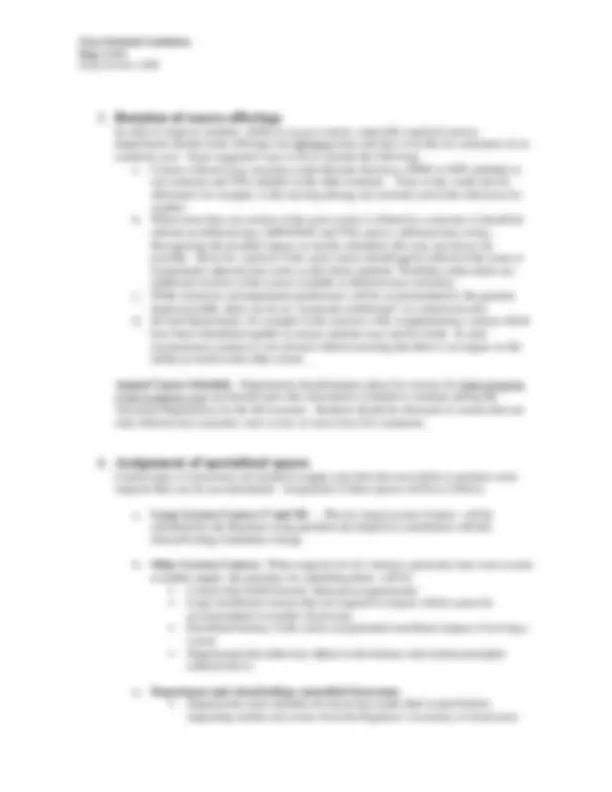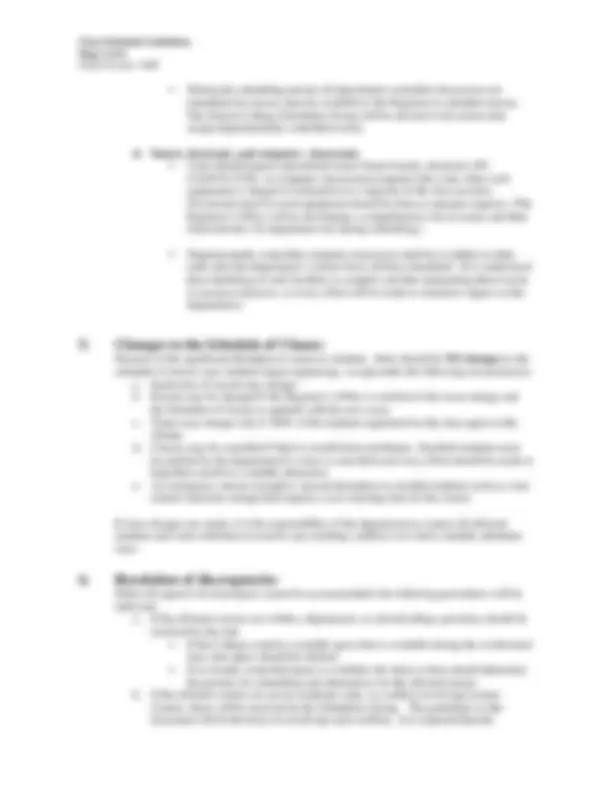





Study with the several resources on Docsity

Earn points by helping other students or get them with a premium plan


Prepare for your exams
Study with the several resources on Docsity

Earn points to download
Earn points by helping other students or get them with a premium plan
Community
Ask the community for help and clear up your study doubts
Discover the best universities in your country according to Docsity users
Free resources
Download our free guides on studying techniques, anxiety management strategies, and thesis advice from Docsity tutors
The university scheduling process, including standardized time zones, schedule balance principles, and guidelines for changes to the Schedule of Classes. It covers undergraduate and graduate courses, with a focus on maximizing classroom usage and student access.
What you will learn
Typology: Study notes
1 / 6

This page cannot be seen from the preview
Don't miss anything!




University at Albany, SUNY Course Scheduling Guidelines Draft 4.
Preamble The Schedule of Classes is one of the primary tactical “artifacts” of a University. Requiring input from and interaction among all corners of the university, the scheduling process involves consideration of academic program needs, faculty availability and preferences, facility limits, finance and budget planning, and processes of the Registrar’s office. Schedules also seek to accommodate various individual need (students’, faculty, and departments) while allocating common resources (space, time, and dollars).
Because faculty best understand the curricula and pedagogical requirements of their courses, a department’s proposed schedule will be accommodated to the greatest degree possible. However, experience reveals that inevitably not all requests can be accommodated due, primarily, to facility limitations. In addition, overall student needs may produce demands at odds with the plans of individual departments. Therefore, common guidelines for managing the extremely complex process of developing a semester’s (and academic year’s) course schedule have been developed, with the goal of achieving a more effective schedule with more equitable and transparent allocation of space.
Portions of these guidelines have been “piloted” in the Spring 2007 schedule. It is intended that they will become fully implemented with the Schedule of Classes for Fall 2007, recognizing that departments may adapt to them at differing speeds.
Establishing standardized time zones is the most effective and efficient way to ensure the maximum use of the instructional week, and to facilitate scheduling of facilities. This is done while recognizing that University facilities must accommodate the needs of many academic programs serving a variety of student populations. Making use of the standard time zones offers the best possible chance for departmental schedule requests to be accommodated. Classes at non-standard time zones can only be scheduled after other requests have been accommodated. Following are the standard times zones:
Undergraduate Courses The following time zones are established by University Policy for undergraduate courses. The BASIC semester class periods last for 55 OR 80 MINUTES; thus a three-credit course normally meets on MWF for 55 minutes each day OR on TTH or MW for 80 minutes each day. Once-a-week three-credit courses meet for 170 minutes. Ten minute intervals separate the time zones to allow transition time from one class to another.
UNDERGRADUATE Class Time Zones for Three-Credit Courses Course meets: Course meets: Course meets: Three times a week Twice a week Once a week MWF 8:15 – 9:10 AM TTH 8:45 – 10:05 AM M/T/W/TH/F 2:45 – 5:35 PM MWF 9:20 – 10:15 AM TTH 10:15 – 11:35 AM M/T/W/TH/F 4:15 – 7:05 PM MWF 10:25 – 11:20 AM TTH 11:45 AM – 1:05 PM M/T/W/TH 5:45 – 8:35 PM MWF 11:30 AM – 12: PM
MWF 12:35 – 1:30 PM MW or TTH 2:45 – 4:05 PM MWF 1:40 – 2:35 PM MW or TTH 4:15 – 5:35 PM MW or TTH 5:45 – 7:05 PM MW or TTH 7:15 – 8:35 PM Courses offering two, four, or five credits, must observe the start times for the time zones of days on which the class is held. This will minimize the number of standard time zones
Page 2 of 6 Draft October 2006
occupied by the course and will give students the greatest flexibility to take other courses during the standard times.
Courses meeting four or five times per week for 55 minutes each must fall within a single TTH time zone. For example a course meeting Monday through Thursday for 55 minutes each day could be scheduled for 9:20 – 10:15 on MW and any 55 minutes within the 8:45 – 10:05 TTH time zone (e.g. 8:45 – 9:40 OR 9:10 – 10:05)
Any request for course offerings outside the normal time zones may not be able to be accommodated.
Graduate Courses Due to the differences in programmatic demands and populations served, graduate courses meet in a variety of time formats. These guidelines are not intended to interfere with the delivery of courses as designed by the faculties of those graduate programs. However, because graduate courses offered on the Uptown Campus utilize the same facilities as undergraduate courses, such graduate courses should begin at the start of a standard undergraduate time zone in order to maximize the use of the classroom. Requests for classrooms that do not begin during a standard time zone may not be able to be fulfilled.
Graduate courses taught at other campuses (Downtown, East, Nanotechnology), where the student populations are self-contained, have utilized different time zones from those on the Uptown Campus. Faculties are encouraged to review course offering patterns on these campuses to ensure that they continue to meet the needs of students served. In addition, the options for improving utilization of classrooms on these campuses, as well as the benefits and drawbacks of standardizing class scheduling to align more closely with the Uptown Campus, will be reviewed in consultation with appropriate faculties on a regular basis by the Schedulers Group (see #7 below) with designated individuals identified by the Deans of the Schools and Colleges
At times, there are more requests for classrooms than there are classrooms available. The time periods of highest demand are TTH at 10:15, 11:45 and 1:15, and the demand for these times has been increasing. However, such clustering of academic offerings into a limited number of time zones or days has a significant ripple effect on the entire scheduling process. It can limit students’ access to needed courses, affect negatively the intellectual climate and culture of the University, overtax facilities and services, and restrict opportunities for student- faculty interaction.
To address such an imbalance and its attendant consequences, each academic unit is expected to offer a schedule distributed across the full week. The following principles of schedule balance should be followed by each department when developing its schedule: a. Each department or program should schedule at least 40 percent of its undergraduate courses on MWF or MW. b. Large lecture classes for 138 or more students with a department should be distributed evenly through the week’s schedule (both day and time of day) c. Discussion sections of classes and labs should be scheduled before 10 am, after 2 p.m., or on Fridays. d. Required courses, where enrollment is assured, should be scheduled into lower- demand time zones (e.g. earlier or later in the day)
Page 4 of 6 Draft October 2006
During the scheduling period, all department-controlled classrooms not scheduled for classes must be available to the Registrar to schedule classes. The School-College Schedulers Group will be advised of all actions that assign departmentally-controlled rooms.
d. Smart, electronic, and computer classrooms Units should request specialized smart (Smart board), electronic (PC, CD,DVD,VCR), or computer classrooms(computer labs) only when such equipment is integral to instruction in a majority of the class sessions. Occasional need for such equipment should be done as separate requests. (The Registrar’s Office will be developing a comprehensive list of rooms and their characteristics for department use during scheduling.)
Departmentally controlled computer classrooms shall be available to other units after the department’s courses have all been scheduled. (It is understood that scheduling of such facilities is complex and that maintaining these rooms is resource intensive, so every effort will be made to minimize impact on the department.)
Because of the significant disruption it causes to students, there should be NO changes to the schedule of classes once students begin registering, except under the following circumstances: a. Instructors of record may change b. Rooms may be changed if the Registrar’s Office is notified of the room change and the Schedule of Classes is updated with the new room. c. Times may change only if 100% of the students registered for the class agree to the change. d. Classes may be cancelled if there is insufficient enrollment. Enrolled students must be notified by the department if a class is cancelled and every effort should be made to help them enroll in a suitable alternative. e. An emergency serious enough to warrant disruption to enrolled students such as a last minute instructor change that requires a new meeting time for the course.
If class changes are made, it is the responsibility of the department to contact all affected students and work with them to resolve any resulting conflicts or to find a suitable substitute class.
When all requests for time/space cannot be accommodated, the following procedures will be followed: a. If the affected courses are within a department, or school/college, priorities should be resolved by the unit. If the College controls a suitable space that is available during the overbooked time, that space should be utilized. If no locally-controlled space is available, the chair or dean should determine the priority for scheduling and alternatives for the affected classes b. If the affected courses are across academic units, or conflicts involving Lecture Centers, these will be resolved by the Schedulers Group. The guidelines in this document will be the basis for resolving such conflicts. It is expected that the
Page 5 of 6 Draft October 2006
Schedulers Group as a whole will have options to generate creative solutions of mutual benefit.